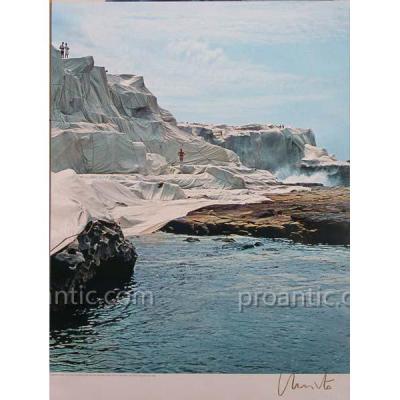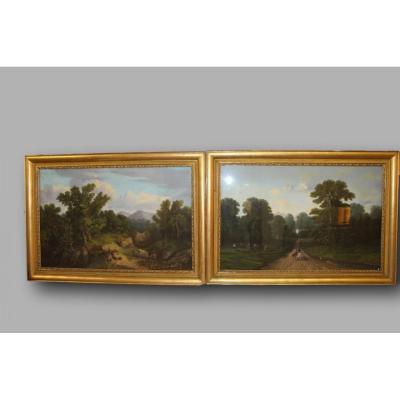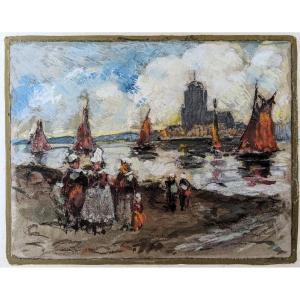Henri Jules Charles DE GROUX (1866-1930) Namur, Belgium: "Farandole" Pastel signed lower left; Size 75 x 104cm Henry de Groux is a Belgian symbolist painter, engraver and sculptor, born November 16, 1866 near Brussels and died January 12, 1930 in Marseille. Biography The outraged Christ Ride of the Valkyries (ca. 1890) Portrait of Verlaine Son of the Belgian painter Charles de Groux, defender of social realism in painting, Henry de Groux trained at the Brussels Academy. At the age of 22, he produced Le Christ aux outrages, a painting that would make him famous. Member of the group L'Essor in 1884, he was accepted in 1886 to the group of XX but was forced to resign in 1890 for having refused to exhibit in the same room as van Gogh and for having insulted him and Paul Signac. and Toulouse-Lautrec. He then moved to Paris where he produced most of his work and rubbed shoulders with other artists such as Toulouse-Lautrec, Whistler, Gauguin, Ensor, Rodin and Debussy. He also frequented many writers, including his future son-in-law Émile Baumann, Mallarmé, Apollinaire, Oscar Wilde, Léon Bloy — with whom he maintained a close friendship — Verlaine, Zola, Heredia, Gide, Milosz, Rémy de Gourmont and Huysmans. He took sides in the Dreyfus affair and ensured the protection of Zola against the hostile crowd at the exit of the court. He produced several portraits of the writer (lithograph, pastel) and a painting, kept at the Zola house in Medan, retracing the episode of leaving the courthouse as he recounts it in his diary on the date of 9 February 1898: "Zola in outrage". This position in favor of Dreyfus and Zola contributes to the deterioration of his friendship with Léon Bloy and to the resounding rupture which occurs between the two men in June 1900. They will not see each other again until the end of 1916, a few months before Bloy's death.
Circulating throughout Europe, de Groux exhibited in Paris, including at Le Barc de Boutteville in 18941, in Brussels, Ostend, Spa, Amsterdam, London and Florence. In the latter city, where he arrived in 1903, hoping to relaunch his career by confronting a new audience, he was accompanied by Germaine Lievens, niece of his wife with whom he had a passionate love relationship. Rubbing shoulders with the artistic and social circles of the city, stimulated by frequentation of the Uffizi museum and other artistic treasures of Florence, he produced a considerable number of works and organized a major exhibition of his works at the Corsini palace in 1904. Always confronted to terrible financial difficulties, brutally assailed by a violent crisis of jealousy vis-à-vis Germaine Lievens, he was interned in the psychiatric hospital of San Salvi, in Florence, in June 1904. After a few weeks, he left escape to reach Genoa on foot. From there, he embarks for Marseilles, where his wife Marie picks him up and brings him back to Spa, in Belgium. He illustrated many literary works. He participated as a lithographer in L'Estampeoriginale (1893) and L'Épreuve (1895). From the end of 1909, he also devoted himself to sculpture: he produced busts of Wagner, Beethoven, Baudelaire, Edgar Poe, Balzac, Tolstoy, Shakespeare, Byron, Villiers de l'Isle-Adam, Emmanuel Signoret, and large full-length statues: Tolstoy, Ecce Homo. He is the author of the statue of the monument to the dead of La Roque d'Anthéron. Several of his major projects as a sculptor are not finalized: of the great monument to the memory of Claude Debussy, only the photos of a few models and the bronze bust of the composer remain, kept in Paris at the Musée de l'Opéra. Between 1892 and 1910, he kept a diary, filling in 18 handwritten notebooks (additions were also made between 1926 and 1928). The whole was deposited by the painter's heirs at the INHA and a partial edition was made in 2007 by Kimé editions. It is quoted in the preamble to Léon Bloy's book The Poor Woman: "With the exception of our great painter Henry de Groux, who then has descended as deeply as you and with such good heart into my black pit? (Edition La Part Commune, 1897).

























 Le Magazine de PROANTIC
Le Magazine de PROANTIC TRÉSORS Magazine
TRÉSORS Magazine Rivista Artiquariato
Rivista Artiquariato
